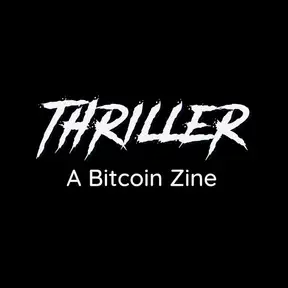Thriller Insights: The Repo Market Meltdown
Download MP3The Real Story Of The Repo Market Meltdown, And What It Means For Bitcoin:
Last week the financial system ran out of cash. It was a modern version of a bank run, and it’s not over yet. Stepping back, it reveals two big things about financial markets: first, US Treasuries are not truly “risk-free” assets, as most consider them to be, and second, big banks are significantly under-capitalized. The event doesn’t mean another financial meltdown is necessarily imminent—just that the risk of one is heightened—since the brush fire can be doused either by the Fed, or by the banks raising more equity capital. However, it provides a “teachable moment” regarding systemic fragility and anti-fragility.
What’s Happening, In Plain English?
Somebody—probably a big bank—needs cash so badly that it has been willing to pay a shockingly high cost to obtain it. That’s the layman’s explanation of what’s happening. Interest rates have betrayed common sense—interest rates in the repo market should be lower than rates in unsecured markets, for example, because repos are secured by assets and thus supposedly lower-risk. But repo rates spiked way above unsecured lending rates last week, even for “risk-free” collateral such as US Treasuries.
But US Treasuries are not risk-free. Far from it. (By this, I’m not referring to the US potentially defaulting on its debt obligations. Rather, I’m referring to the practice in the repo market that allows more people to believe they own US Treasuries than actually do. It’s called “rehypothecation.”) Why was someone willing to borrow cash at a 10% interest rate last Tuesday, in exchange for pledging US Treasury collateral that yields only 2% or less? That trade lost someone a whopping 8% (annualized) overnight, but presumably the trade allowed the bank to stay in business for another day. As risk premiums go, 8% is shockingly high—for a supposedly risk-free asset!
At a systemic level, the traditional financial system is as fragile as Bitcoin is anti-fragile.
An anti-fragile system is one that becomes stronger and more resilient as a result of shocks, not weaker. This describes Bitcoin, whose network security grows as the system’s processing power grows. Here I distinguish between price volatility and systemic volatility. Bitcoin’s price is highly volatile, but as a system it is more stable. In stark contrast to the traditional financial system, Bitcoin is not a debt-based system that periodically experiences bank run-like instability. In this regard, Bitcoin is an insurance policy against financial market instability. Bitcoin is no one’s IOU. It has no lender of last resort because it doesn’t need one. For me, Bitcoin is empowering because it provides a choice to opt out of the traditional financial system. In light of the traditional financial system’s instability, despite all of Bitcoin’s drawbacks, I find that a powerful concept.
Coin Analysis: Bitcoin
Last week the financial system ran out of cash. It was a modern version of a bank run, and it’s not over yet. Stepping back, it reveals two big things about financial markets: first, US Treasuries are not truly “risk-free” assets, as most consider them to be, and second, big banks are significantly under-capitalized. The event doesn’t mean another financial meltdown is necessarily imminent—just that the risk of one is heightened—since the brush fire can be doused either by the Fed, or by the banks raising more equity capital. However, it provides a “teachable moment” regarding systemic fragility and anti-fragility.
What’s Happening, In Plain English?
Somebody—probably a big bank—needs cash so badly that it has been willing to pay a shockingly high cost to obtain it. That’s the layman’s explanation of what’s happening. Interest rates have betrayed common sense—interest rates in the repo market should be lower than rates in unsecured markets, for example, because repos are secured by assets and thus supposedly lower-risk. But repo rates spiked way above unsecured lending rates last week, even for “risk-free” collateral such as US Treasuries.
But US Treasuries are not risk-free. Far from it. (By this, I’m not referring to the US potentially defaulting on its debt obligations. Rather, I’m referring to the practice in the repo market that allows more people to believe they own US Treasuries than actually do. It’s called “rehypothecation.”) Why was someone willing to borrow cash at a 10% interest rate last Tuesday, in exchange for pledging US Treasury collateral that yields only 2% or less? That trade lost someone a whopping 8% (annualized) overnight, but presumably the trade allowed the bank to stay in business for another day. As risk premiums go, 8% is shockingly high—for a supposedly risk-free asset!
At a systemic level, the traditional financial system is as fragile as Bitcoin is anti-fragile.
An anti-fragile system is one that becomes stronger and more resilient as a result of shocks, not weaker. This describes Bitcoin, whose network security grows as the system’s processing power grows. Here I distinguish between price volatility and systemic volatility. Bitcoin’s price is highly volatile, but as a system it is more stable. In stark contrast to the traditional financial system, Bitcoin is not a debt-based system that periodically experiences bank run-like instability. In this regard, Bitcoin is an insurance policy against financial market instability. Bitcoin is no one’s IOU. It has no lender of last resort because it doesn’t need one. For me, Bitcoin is empowering because it provides a choice to opt out of the traditional financial system. In light of the traditional financial system’s instability, despite all of Bitcoin’s drawbacks, I find that a powerful concept.
Coin Analysis: Bitcoin

